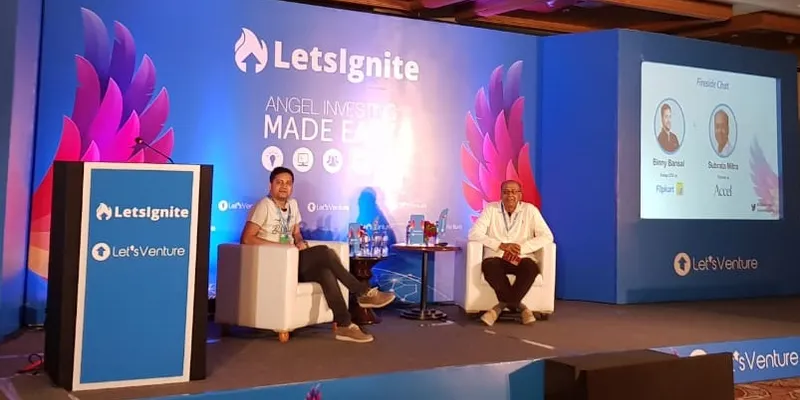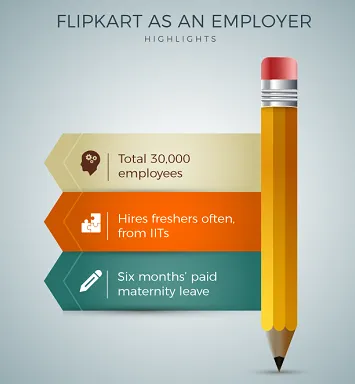Binny Bansal rewinds to the beginning of Flipkart, and a future without Sachin Bansal
Speaking at the 5th edition of LetsIgnite, Binny Bansal chats about how Flipkart started out, built a brand and work culture, invested in the ecosystem, and reveals plans for the next 10 years.

When Binny Bansal and Sachin Bansal started up in 2007, ecommerce was practically unheard of in India. Internet penetration was dismal, credit cards were rare, and earning trust for a consumer internet startup was a wild ambition.
But, beating all odds, the duo built a company that inspired a generation of entrepreneurs and kicked off a startup revolution. The two Bansals (not related) became poster boys of the Indian startup ecosystem.
Eleven years later, after Flipkart’s exit to US retailer Walmart in May, Sachin left the company, leaving Binny to continue as the Flipkart Group CEO.
In a rare public appearance after the biggest ecommerce deal in Indian history, Binny Bansal spoke to Subrata Mitra, Partner at Accel Partners, one of the earliest investors in Flipkart, at the 5th edition of LetsIgnite – an angel-focused conference in Bengaluru on Saturday. He spoke to an audience of aspiring entrepreneurs, early stage startups, angel investors, and VCs.
(Besides Flipkart’s many investments and acquisitions, Binny is an angel investor in startups like Unacademy, Curefit, Stellapps, and SigTuple, among others. Subrata’s Accel portfolio includes not just Flipkart and Myntra, but also JusPay, Moglix, MySmartPrice, and ScripBox, among others.)
The initial days
Subrata is one of the very few who witnessed the initial days of the two youngsters fresh out of Amazon India, wanting to build ecommerce in India. He reminisced about meeting Sachin and Binny in 2008. “When we first met, we had just rejected the idea of being a price comparison website and moved entirely to ecommerce.”
Binny elaborated, “When Sachin and I were discussing ideas on what we could work with, we were clear on what we knew and what we didn’t know. We knew internet and we knew how to code, but not how to run a business. So we looked at various business models and thought that comparing prices was fairly easy for developers to start.”
There was not much happening in that space in India and the duo researched all the shopping sites in India. “There was no online shop that we would buy from; then why would any regular customer? So we decided to build one. This decision was taken easily, in a month or so, as there was nothing else out there,” Binny reminisced.
Subrata asked what audience was thinking. When you are pivoting, what should you look at?
“Pivoting is a broad term. With all my wisdom today, I would say that you should look at a market that is big enough. In that market, achieve what you are passionate about, and which you have skills for,” said Binny, agreeing with Subrata on ensuring a differentiation if there are other players doing something similar.
“You have to have a clear vision – why you are doing it if there are other people in the market, and how you are doing it differently,” he said.
Impressive ideation
Subrata remembered what most impressed him about Sachin and Binny when they first met. According to him, the duo worked through issues rapidly, and never backed away from a challenge. “You went on to innovate at different levels – like introducing CoD, Ekart etc. How did you decide to do it in-house?” Subrata wondered.
About their thought process behind big innovations, Binny said, “In our early days, building Ekart was about building last-mile delivery. It was a major milestone for operations at Flipkart. We had just started cash-on-delivery six months ago. Most of our logistics partners were struggling with CoD, as their processes were not built for that service. Our NPS and customer satisfaction were dipping even though Flipkart had 30 percent monthly growth. No amount of meetings and brainstorming sessions with these partners could get it to work. That’s where we decided to try – not do.”
Binny went on to explain that rather than taking big bets, Sachin and he decided to launch in just three locations in Bengaluru, with 15-20 delivery boys in the pilot. “In a couple of months, customer satisfaction shot up through the roof, and repeat rate grew by 30-40 percent. It was black and white, and we decide to scale it,” he says about their big turning point.
The other big innovation for Flipkart at the time was in marketing, Binny recollected. “We started with books, and later added the electronics and mobile phones categories. But the high ticket items were harder to sell. We figured that customers needed to see a trusted brand when they bought electronics online, and needed assurance of warranty and returns. So we rebranded the campaign, offering no-questions-asked returns, genuine warranty, and CoD. We packaged all three together, and witnessed10x growth in just one year.”
Building the right culture
Sustaining the work culture in the early days is tough, especially when your team grows to a thousand (and more) people. Flipkart, according to Subrata, had put together an impressive team with around 50 people in the beginning itself.

When he asked Binny how they managed to maintain it, Binny replied, “As founders, Sachin and I knew that the business could scale only if we added the right people to the mix. We were hiring people from different levels into the company, and by trial and error, figuring out what worked best – what you call the culture fit.”
Subrata remembered the two youngsters hiring people for their innate ability to learn, as opposed to experience. Binny added, “We figured that what we needed were talented people who were passionate about making an impact. So we looked for raw talent, people willing to learn rather than people with 15-20 years of experience and who would tell us what to do. Ecommerce was new, and nobody knew what to do,” Binny recollected.
(Subrata vaguely mentioned an offline book retailer whom they hired, a move that didn’t work.)
Elaborating, Binny said, “We had hired some people from retail companies and some with experience in product management. But one good thing about our culture was that when we realised it was working out we were quick to mutually separate. That is very important at the early stage - once you know it is not working, separating is very important. I think what worked for us were people who were passionate about learning and make an impact. We were able to track talented, sharp people – everybody was like that; the freedom and responsibility given to them were way more than what they would get in any traditional company.”

In a way, they were looking to make other people entrepreneurial. “That was the model that worked for us with 2-3 employees at the beginning –Sujeet as the Operations head and Mekin as tech head,” said Binny, adding that what works for you in the initial 3-4 years does not work after that.
“Once you get a larger scale, you need the right mix. Because then big parts of your business are not in startup mode any more. We needed people with relevant experience and those who continue to bring in the startup culture, and marry the two to keep the vision clear,” he added.
Building a brand
Subrata recounted that Flipkart’s pitch to Accel Partners was about creating a brand with best customer loyalty. But how do you build a brand?
“There are two parts to building a culture: About 80 percent is your product; the rest is what you do everyday – building your products, how you behave with customers, stakeholders and even internally among employees. For me, customer loyalty was key. That became synonymous with our brand. Only the other 20 percent is the perception you build a personality for the brand.”
Among Flipkart’s marketing campaigns, ads around kids were the most popular.
“The first ads were lame. Sachin and me were the marketing heads; we had no experience. We hired an experienced marketing head, Ravi Vora, who was earlier with Heinz and Unilever. He worked with another startup Happy Creative Services, who came up with the kids’ idea.”
The whole idea of the ‘Flipkart kids’ campaign was that Flipkart shopping was so easy that even children could do it easily. The campaign launched in 2012 and continues to this day.
Working in unison
Sachin and Binny have always worked in unison. It was always known that between the two Co-founders of Flipkart, Sachin was the visionary, intuitive and spontaneous, while Binny was the backend guy. (They started off as Sachin being CEO and Binny as COO.)
“Did you have a natural flair, or did the company need it?” Subrata asked.
Binny said things developed organically, there were no defined roles at the beginning. “We were both working in marketing, backend, etc. But as time passed, Sachin was better than me at designing the website, marketing, SEO, and SEM. He was more intuitive. I couldn’t get my head around it. So I said, okay, you do it.”
He added that meeting vendors, creating catalogues, customer support, automation etc. came more intuitively to him. “So within 4-5 months, the roles carved themselves out. Sachin would think ahead, and grow the business and customer base, while I focused on scaling it 10x.”
How to get the best out of acquisitions
No conversation about the Flipkart story is complete without its many acquisitions – the most successful one being online fashion seller Myntra.
“We have been quite lucky in acquisitions. Till two years ago, we did not have an acquisition strategy. We were mostly looking at what was happening in the market. It worked out well for us because we were clear about what we were doing, and what the opportunities were.”
Myntra and Flipkart had a common investor in Accel Partners. “Mukesh and we bumped into each other often. We knew what both companies were doing, and what our opportunities were. Initially we thought that Myntra and Flipkart fashion were too similar; we later figured that both had different ways of selling, different customer bases, target segments, and were building fashion ecommerce very differently. In fact, the conversations on acquisition began one year before it actually happened,” Binny said.
Fashion is the most important segment in ecommerce in terms of margin and customer retention. “Once we were clear that this would grow the ecommerce business, help us differentiate, and give us more market share, we made the decision,” Binny added.
What is important in an acquisition? The reason both parties want to do it, staying true, and being in sync, he said. “We had great chemistry with Mukesh,” he added.
Investing in the ecosystem
Flipkart’s more recent acquisitions include PhonePe, Ebay India, and F1 Info Solutions. They have invested in two startups - TinyStep and NestAway. But Binny says that Flipkart will invest less in companies now.
“There was a time when we had more cash than we needed. So we were investing in some non-strategic areas. But I have learnt that startups should use cash for furthering strategic interests and making a differentiation - if they give you exclusivity or some business upside, which you won’t get otherwise (without investing). The capital you raise is not for investing because you are not in the investment business. The only investments we will do from now on are strategic in nature.”

Although Flipkart is now 11 years old, Binny said it was still early days for the company. Asked what Flipkart is aiming for in the next 10 years, he said, “I think the next 30 years will be more exciting. Till now, we were building a foundation on tech, team, infrastructure, a large customer base, and a trusted brand. Those are our assets. As tech becomes more progressive in the next 10 years, there will be more opportunities and more categories with more penetration. Apart from mobiles, all categories have penetrated less than 7-8 percent. Ecommerce should be 30-40 percent of all retail.”
Binny added that Flipkart would build on the foundations it had laid. “There are other opportunities – like in the financial services space with PhonePe. It started two years ago. Like Flipkart’s initial years, PhonePe is growing 30-40 percent monthly. The future of financial services is digital; we see ourselves playing a critical role in it,” he said.
On an audience query on Sachin leaving the company, Binny signed off: “Sachin has had a crucial role in building the company. He was CEO for the longest time at Flipkart. His vision steered us. Going forward, there are different things he and I wanted to do. It was a good time, because a major investor was coming in."







